Research projects supported by
- National Science Foundation (NSF), USA
- Ministry of Trade, Industry and Energy (MOTIE), South Korea
- San Diego State University (SDSU), USA
- National Research Foundation (NRF), Singapore
- National Medical Research Council (NMRC), Singapore
- Ministry of Education (MOE), Singapore
- National University of Singapore (NUS), Singapore
- Advanced Research Projects Agency – Energy (ARPA-E), USA
- National Aeronautics and Space Administration (NASA), USA
- Rockwell Automation, USA
- Teledyne Scientific Company, USA
Current and past research projects:
1. Tribo-charge driven wetting (TCW): A New Wettability Control Mechanism for Electric-Free Droplet Manipulation

Tribo-charge driven wetting (TCW) is presented as a fundamentally new, electric-free mechanism for active wettability modulation. In contrast to voltage-driven wetting control in EWOD, TCW employs surface charges generated through contact electrification to modulate surface tensions, completely eliminating the need for traditional EWOD components such as electrodes, wiring, and power supplies (Advanced Science, e11863, 2025).
2. Electrowetting-driven solar indoor lighting (e-SIL): an optofluidic approach towards sustainable buildings

Rooftop sunlight is collected by a solar collector and guided to individual rooms along an optical fiber (waveguide) on the bottom of which tunable liquid prisms are linearly integrated. (a) At the light-off mode, electrowetting controls the prism angle to be φ = 0°. Incoming sunlight undergoes total internal reflection and thus keeps propagating along the optical fiber without leaking to the prism bottom for indoor lighting. (b) When liquid prisms are controlled to have the angle at φ > 0°, incoming sunlight is partially transmitted to the bottom surface of the arrayed prisms to contribute to indoor illumination (Lab on a Chip, 18, 1725-1735, 2018).
3. An optofluidic solar energy collection system
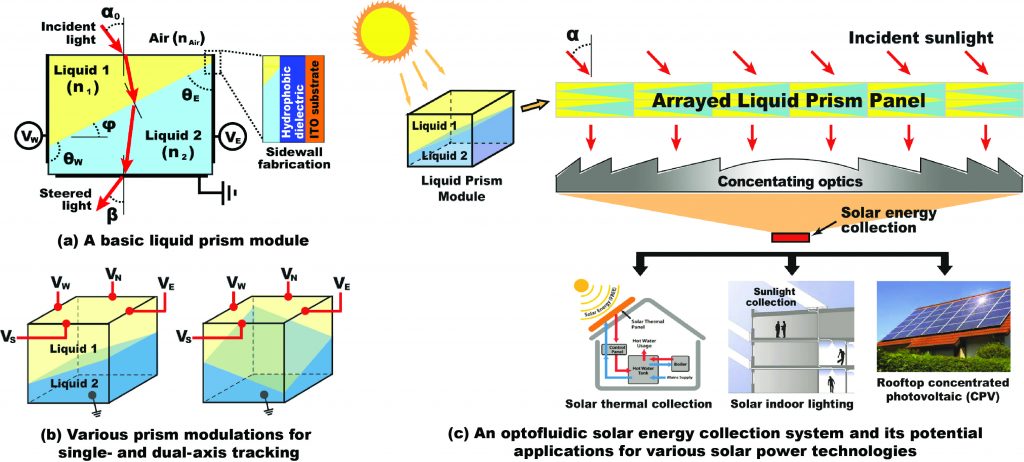
A basic prism module is stacked up and expanded to achieve an arrayed prism panel, which enables solar tracking as wide as ±80° and solar concentration as high as 2032x without any mechanical moving components. This optofluidic solar energy collector can be potentially useful for various solar power technologies such as solar thermal heating, solar indoor lighting, concentrated photovoltaic (CPV), concentrated solar power (CSP), and solar thermo-chemical reactions (Applied Energy, 162, 450, 2016).
4. A smartphone integrated paper (SIP)-based platform for rapid and on-site screening of urinary tract infections

A smartphone integrated paper (SIP)-based system enables accurate screening of urinary tract infections (UTIs) by directly identifying white blood cells (WBCs) in human urine samples. The SIP platform mainly consists of a paper-based capillaric filter and a smartphone-integrated fluorescence microscope. A paper filtration device allows a low-cost, simple method for selectively dying and isolating target WBCs in urine with more than 95% collection efficiency using capillary action through paper layers with several different pore sizes without extra pumps and tubes typically required for fluidic actuation in microfluidic systems. Furthermore, an integrated smartphone can be conveniently used for fluorescence imaging of the stained WBCs and microscopic analysis to rapidly provide UTI diagnostic results at the point of care without the need of bulky laboratory equipment and specialized training (Sensors and Actuators B: Chemical, 382, 133498, 2023).
5. Smartphone integrated optoelectrowetting (SiOEW) device for on-chip water quality sensing
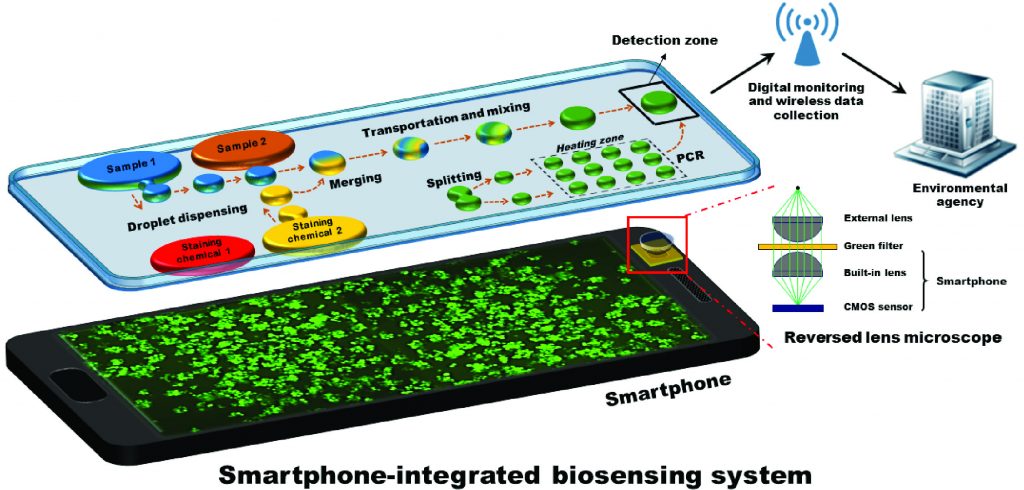
With the increasing capabilities and ubiquity of smartphones and their associated digital cameras, high-performance display, and wireless communication, the SiOEW device offers a fully-integrated portable platform capable of on-chip water sample preparation and microscopic detection of the target cells , which significantly reduce the sample preparation and detection time and the labor cost by allowing timely and distributed detection of water quality. A commercially available smartphone is used as a low-intensity portable light source to perform optoelectrowetting-based pumpless and tubeless microfluidic operations such as droplet transportation, merging, mixing, and immobilization on a hydrophobic detection zone. Furthermore, a built-in smartphone camera allows to implement a simple and low-cost microscope system capable of 115x magnified imaging to achieve on-chip detection of target contents. A smartphone further allows the captured information (e.g. the location and the time of the target water sample detected, the number of the target cells, etc.) to be rapidly and wirelessly shared with a central host such as an environmental regulation agency for real-time monitoring of microbial water quality and further water quality management (Lab on a Chip, 18, 532, 2018).
6. A high-capacitance ion gel dielectric for energy applications
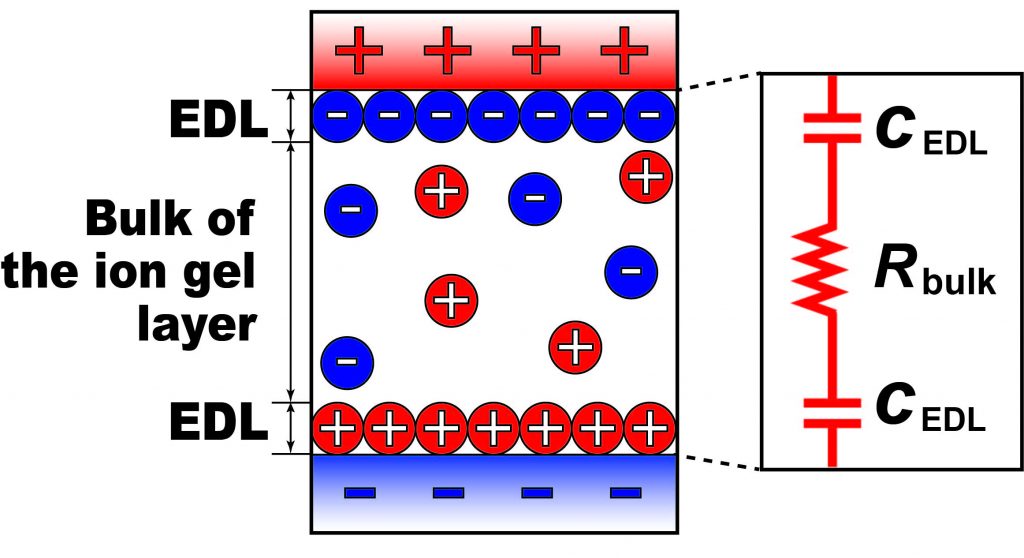
An ion gel offers a 2 to 3 order higher specific capacitance (c ≈ 10 μF/cm2) than that of conventional dielectrics such as SiO2 and Al2O3, while being fabricated through a simple low-cost spin- or dip-coating process. Such an extremely high capacitance results from the nanometer-thick electric double layer (EDL) capacitor formed by the compact accumulation of free counter-ions at the interface under an applied electric field. Thus, the capacitance of the ion gel layer is thickness-independent (Langmuir, 31, 8512, 2015).
7. High-performance beam steering using an electrowetting-driven liquid prism
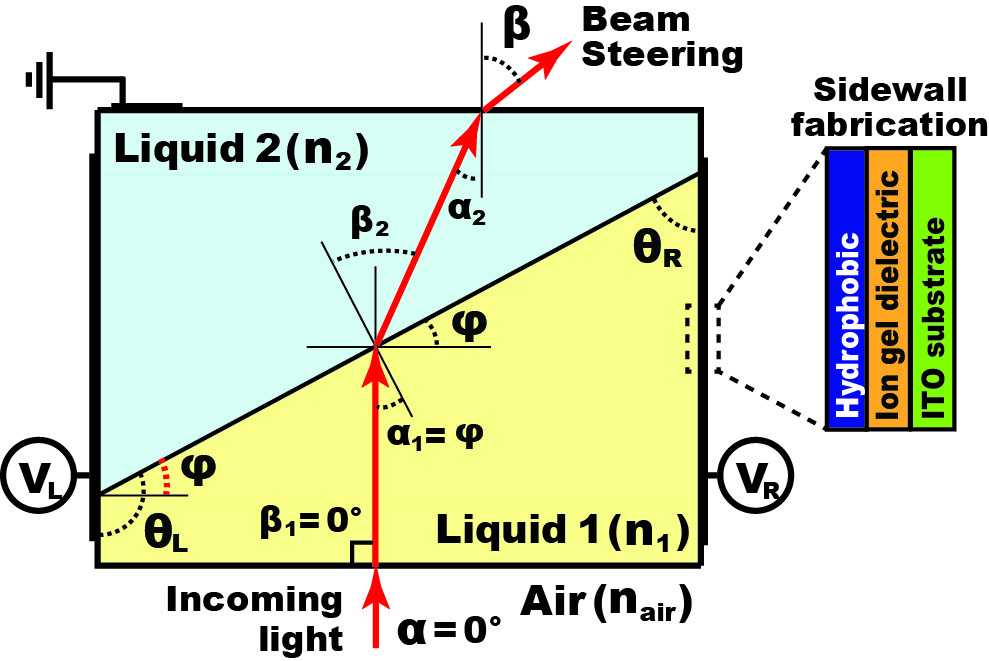
Four prism sidewalls are assembled and dip-coated with a dielectric (ion gel) and a hydrophobic layer. An electrowetting effect controls the prism angle φ by applying bias voltages to the left and right sidewalls, separately. Due to the refractive index difference (nair ≠ n1 ≠ n2) of each medium, incoming light can be effectively steered without any bulky mechanical moving components (Applied Physics Letters, 108, 191601, 2016).
8. An optofluidic prism array for 3D spatial focal control
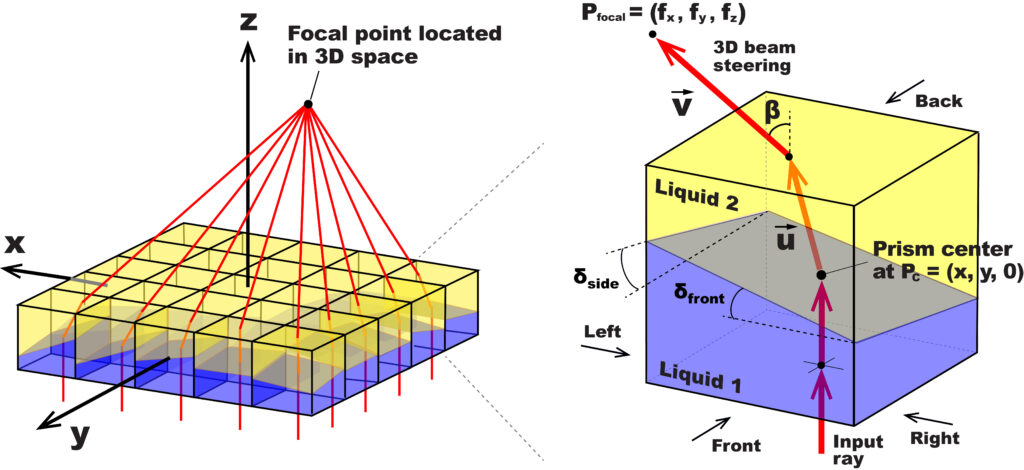
A new lens capability for three-dimensional (3D) focal control is presented using
an optofluidic system consisting of n × n arrayed liquid prisms. Each prism module contains two immiscible liquids in a rectangular cuvette. Using the electrowetting effect, the shape of the fluidic interface can be rapidly adjusted to create its straight profile with the prism’s apex angle. Consequently, an incoming ray is steered at the tilted interface due to the refractive index difference between two liquids. To achieve 3D focal control, individual prisms in the arrayed system are simultaneously modulated, allowing incoming light rays to be spatially manipulated and converged on a focal point located at Pfocal (fx, fy, fz) in 3D free space (Optics Express, 31, 17677, 2023).